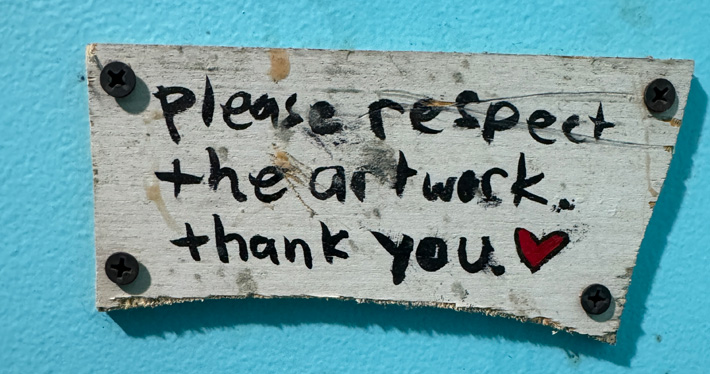
Strong Rope Brewery in Brooklyn sends a message
A programming note: Looking at the calendar, I see that Christmas and New Year’s Day fall on Mondays, so no Monday links here until Jan. 8.
The year about to end will be the first one, with the exception of Covid-depressed 2020, that the sum of beers produced by the breweries categorized as “craft” did not increase. That goes back to when the Institute of Brewing Studies was collecting the statistics for microbreweries and brewpubs and had not yet defined “craft brewery.”
(The IBS was a subsidiary of the Association of Brewers, which merged with the Brewers Association of American in 2005 to form the Brewers Association.)
A “Year in Beer” summary produced by the Brewers Association and chief economist Bart Watson’s presentation last week for association members and the press both focused on the business of beer. They made it clear that the numbers reflect an ongoing trend, and that 2024 will be just as challenging for breweries.
Why should beer drinkers care? For one thing, if your favorite brewery goes out of business you’ve lost something. So consider Watson’s last two slides. He suggested that “most of the challenges craft faces have opportunities in craft strengths.” Flavor and variety matter, a wide range (including next to zero) ABVs serve different occasions well, and where diversity grows niche and local opportunities do as well.
And on the final slide, he asked, “How will you grow occasions in 2024?”
I was reminded of standing outside one of the tents at the first St. Louis Brewers Festival in 2007. Anheuser-Busch invested considerable resources to pour a few of its beers along with six other St. Louis area breweries at the time — a different time, indeed. The festival was a tiny part of A-B’s “Here’s to Beer” national campaign (the url herestobeer.com now redirects to A-B and the Wayback Machine gets stuck at the age check gate, which is too bad; fun to see that mid-aughts thinking).
Bob Lachky, executive vice president of Global Industry and Creative Development, was an enthusiastic proponent of the promotion. He was a man pretty good at his job, and credited with the “I Love You, Man” and “Whassup?!” campaigns as well as the Budweiser frogs. Bud Light did quite well when he was the brand manager.
(He was less than impressed with everything related to Dylan Mulvaney earlier this year. “It took us 20 years to take Bud Light beer to the No. 1 beer in the country, and it took them one week to dismantle it,” he told the St. Louis Post-Dispatch.)
Lachky was drinking a Budweiser, watching attendees head out after the taps closed.
Among other things, he talked about young drinkers turning to spirits to celebrate rather than beer. “We can’t keep losing the occasions,” he said.
Deja vu.
Postcript: Primitive Beer’s Hotbierfest is a pretty good example of how to do a occasion right.
You might also enjoy
– Colorado Grain Chain. Speaking of Primitive Beer, the brewery uses all Colorado-grown grain. And Primitive co-owner Lisa Boldt is the Colorado Grain Chain project manager. The nonprofit Grain Chain is member-supported and, among other things, helps small-scale farmers to network and market their products. “If we as brewers and distillers want the local community to support us, to buy our products and come to our tasting rooms, I think it’s important that we support the local ingredients that go into our products,” Boldt says.
– New York City’s Strong Rope Brewery and the East Coast Cask Revival. It is delightful to see Strong Rope founder/brewer Jason Sahler get this attention. “When I am giving tours I am the face of the beer,” he told me when I visited him in Brooklyn’s Gowanus neighborhood in 2019. “But I tell them all of this is not possible without farmers. The farmers do all the work before (ingredients) touch our deck. It’s easier for me to explain that on a small scale. There’s something more tangible to me when it’s local.”
– Cola Craze: Germans Love America’s Iconic Soda So Much They Put It in Their Beer. Spezi, a blend of Coke and orange soda, was created by Brauerei Riegele in Augsburg in the 1960s. Riegele was founded in 1386. A tour includes the well they draw water from. “This water has never seen humanity. The first thing it sees is beer,” Sebastian Priller-Riegele, a 28th generation brewer, told me when I visited the brewery in 2019. Riegele wins scores of medals for its well-made, Reinheitsgebot-conforming beers, but it seems that award-winning beer isn’t the only reason they have stayed in business for more than 600 years.
– The Best Hidden Gem Places to Drink in 2023. Some of the places sound cool; others not so much. But what I really want to know is if any of the three (three!) spots in Austin, Texas, have a sticker that declares: “THIS IS ONE OF DOUG’S TOP 50 BARS IN AUSTIN.”
You can’t make this stuff up
– HOPnotic spell. A hop water brand has hired a hypnotist “who will hypnotize select consumers to help make sure they stay extra dry this January.” It is a contest, of sorts.
– Blue cheese beer. “We’re always looking for something to ferment, whether it’s sauerkraut or pickles or beer or wine, whiskey, cheese, you name it, it’s all fermented.”
And for the last link of 2023 . . .
I’d rather not point to a post from X, but this seems essential. Yes, do read the comments (replies).
 You know if you know (at which brewery this request is posted)
You know if you know (at which brewery this request is posted)




